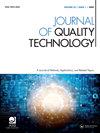The Statistical Analysis of Multivariate Failure Time Data: A Marginal Modeling Approach
IF 2.2
2区 工程技术
Q2 ENGINEERING, INDUSTRIAL
引用次数: 2
Abstract
This book written by Prentice and Zhao brings advances in the specialized field of failure time data analysis. In the existing literature, an extensive study of statistical methods for univariate failure time analysis has been performed. These methods include Kaplan-Meier (KM) estimator, Cox regression, and censored data rank test, etc. However, to my best knowledge, the effort on multivariate failure time data analysis is insufficient. Multivariate failure time data arise when failure times for individuals in a study cohort have a dependent feature, which exists in a number of situations, including epidemiologic studies and clinical trials, etc. The development of statistical methods for multivariate data deserves more research attention. Even though there are several books tackling the problem, they devote the analysis either for select types of multivariate data or have an emphasis on a specific method. Compared with these works, this book makes a summary of the latest innovative research results both deeply and extensively. Overall, the logic of this book is very clear. Chapter 1 gives an overview of the subsequent chapters. It covers a brief introduction to the models and tools and also provides some good application settings. Readers who are not familiar with the topic may read this chapter to grasp the motivation of the study quickly. Chapter 2 describes some core methods that are used to model univariate failure time data. It serves as a solid foundation for the extension to multivariate data analysis; therefore, readers need to pay much attention to this chapter. Chapters 3 and 4 provide tools for analyzing bivariate failure time data from the nonparametric and regression perspectives, respectively. In Chapters 5 and 6, the aforementioned models and tools are extended to cover the scenario of three or more failure time variates. Chapter 7 further considers the case of recurrent event data. Finally, the book concludes with Chapter 8, which discusses approaches to handling more general assumptions, such as dependent censorship and mismeasured covariate data. As implied by the title, the marginal modeling approach is the most important and unique feature of this book. This approach has been described in detail by Sections 4.6, 5.4, and 6.5. Under this approach, a Cox-type model for the marginal double or triple or multiple failure hazard rates is utilized to explain the effects of time-dependent covariates. Some strengths provided by this approach make it distinct from the three conventional approaches: 1) the frailty approach, 2) the copula approach, and 3) the counting process intensity modeling. For example, the copula approach imposes a strong assumption on the dependencies among failure times and doesn’t allow such dependencies to depend on covariates. In contrast, the marginal approach provides robustness by conducting semiparametric estimates of the dependency. In short, the contributions of this book consist of多变量失效时间数据的统计分析:一种边际建模方法
这本由Prentice和Zhao撰写的书在故障时间数据分析的专业领域取得了进展。在现有文献中,对单变量失效时间分析的统计方法进行了广泛的研究。这些方法包括Kaplan-Meier (KM)估计、Cox回归和删减数据秩检验等。然而,据我所知,对多元失效时间数据分析的努力是不够的。当研究队列中个体的失败时间具有依赖特征时,就会出现多变量失败时间数据,这种情况存在于许多情况下,包括流行病学研究和临床试验等。多元数据统计方法的发展值得更多的研究。尽管有几本书解决了这个问题,但它们的分析要么是针对选择的多变量数据类型,要么是强调一种特定的方法。与这些著作相比,本书对最新的创新研究成果进行了深入而广泛的总结。总的来说,这本书的逻辑非常清晰。第一章概述了后面各章的内容。它简要介绍了模型和工具,并提供了一些很好的应用程序设置。不熟悉主题的读者可以阅读本章,以便快速掌握学习的动机。第2章描述了一些用于单变量失效时间数据建模的核心方法。它为扩展到多变量数据分析奠定了坚实的基础;因此,读者需要对这一章多加关注。第3章和第4章分别从非参数和回归的角度提供了分析二元失效时间数据的工具。在第5章和第6章中,上述模型和工具被扩展到涵盖三个或更多故障时间变量的场景。第7章进一步考虑了重复事件数据的情况。最后,本书以第8章结束,其中讨论了处理更一般假设的方法,例如依赖审查和误测协变量数据。正如书名所暗示的那样,边际建模方法是本书最重要也是最独特的特点。第4.6、5.4和6.5节详细描述了这种方法。在这种方法下,利用边际双重、三重或多重失效危险率的cox型模型来解释时变协变量的影响。该方法提供的一些优势使其与三种传统方法不同:1)脆弱性方法,2)copula方法和3)计数过程强度建模。例如,copula方法对故障时间之间的依赖关系施加了很强的假设,并且不允许这种依赖关系依赖于协变量。相反,边际方法通过对相关性进行半参数估计来提供鲁棒性。简而言之,本书的贡献包括
本文章由计算机程序翻译,如有差异,请以英文原文为准。
求助全文
约1分钟内获得全文
求助全文
来源期刊

Journal of Quality Technology
管理科学-工程:工业
CiteScore
5.20
自引率
4.00%
发文量
23
审稿时长
>12 weeks
期刊介绍:
The objective of Journal of Quality Technology is to contribute to the technical advancement of the field of quality technology by publishing papers that emphasize the practical applicability of new techniques, instructive examples of the operation of existing techniques and results of historical researches. Expository, review, and tutorial papers are also acceptable if they are written in a style suitable for practicing engineers.
Sample our Mathematics & Statistics journals, sign in here to start your FREE access for 14 days
 求助内容:
求助内容: 应助结果提醒方式:
应助结果提醒方式:


